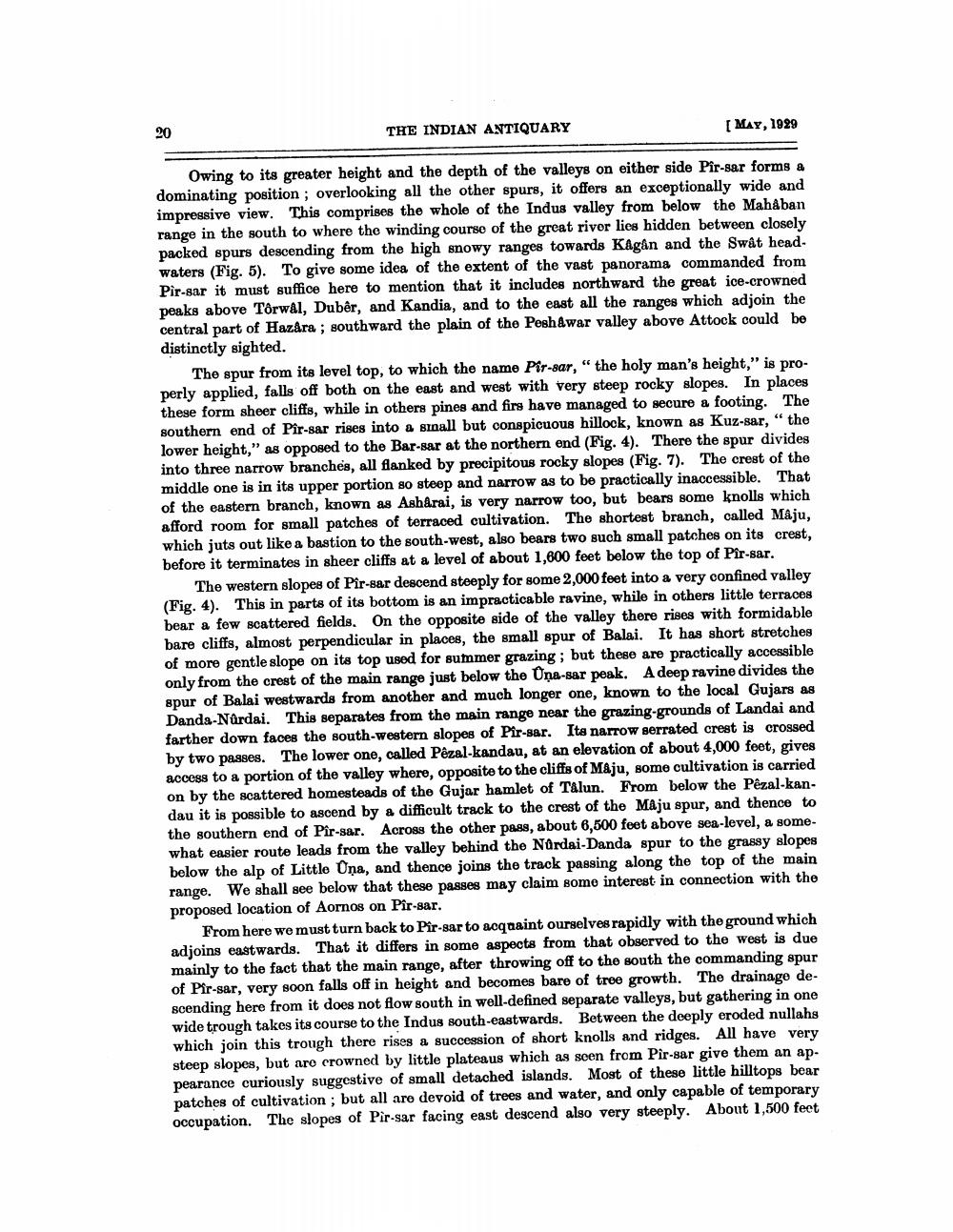________________
20
THE INDIAN ANTIQUARY
[ MAY, 1929
Owing to its greater height and the depth of the valleys on either side Pir-sar forms a dominating position ; overlooking all the other spurs, it offers an exceptionally wide and impressive view. This comprises the whole of the Indus valley from below the Mahaban range in the south to where the winding course of the great river lies hidden between closely packed spurs descending from the high snowy ranges towards Kagan and the Swat head. waters (Fig. 5). To give some idea of the extent of the vast panorama commanded from Pir-sar it must suffice here to mention that it includes northward the great ice-crowned peaks above Torwal, Dubêr, and Kandia, and to the east all the ranges which adjoin the central part of Hazara ; southward the plain of the Peshawar valley above Attock could be distinctly sighted.
The spur from its level top, to which the name Pir-sar, " the holy man's height,” is properly applied, falls off both on the east and west with very steep rocky slopes. In places these form sheer cliffs, while in others pines and firs have managed to secure a footing. The southern end of Pir-sar rises into a sinall but conspicuous hillock, known as Kuz-sar, "the lower height," as opposed to the Bar-sar at the northern end (Fig. 4). There the spur divides into three narrow branches, all flanked by precipitous rocky slopes (Fig. 7). The crest of the middle one is in its upper portion so steep and narrow as to be practically inaccessible. That of the eastern branch, known as Asharai, is very narrow too, but bears some knolls which afford room for small patches of terraced cultivation. The shortest branch, called Maju, which juts out like a bastion to the south-west, also bears two such small patches on its crest, before it terminates in sheer cliffs at a level of about 1,600 feet below the top of Pîr-sar.
The western slopes of Pir-sar descend steeply for some 2,000 feet into a very confined valley (Fig. 4). This in parts of its bottom is an impracticable ravine, while in others little terraces bear a few scattered fields. On the opposite side of the valley there rises with formidable bare cliffs, almost perpendicular in places, the small spur of Balai. It has short stretches of more gentle slope on its top used for summer grazing ; but these are practically accessible only from the crest of the main range just below the Uņa-sar peak. A deep ravine divides the spur of Balai westwards from another and much longer one, known to the local Gujars as Danda-Nûrdai. This separates from the main range near the grazing-grounds of Landai and farther down faces the south-western slopes of Pir-sar. Ita narrow serrated crest is crossed by two passes. The lower one, called Pezal-kandau, at an elevation of about 4,000 feet, gives access to a portion of the valley where, opposite to the cliffs of M&ju, some cultivation is carried on by the scattered homesteads of the Gujar hamlet of Talun. From below the Pêzal-kandau it is possible to ascend by a difficult track to the crest of the Mâju spur, and thence to the southern end of Pir-sar. Across the other pass, about 6,500 feet above sea-level, a somewhat easier route leads from the valley behind the Nordai-Danda spur to the grassy slopes below the alp of Little Una, and thence joins the track passing along the top of the main range. We shall see below that these passes may claim some interest in connection with the proposed location of Aornos on Pir-sar.
From here we must turn back to Pir-sar to acquaint ourselves rapidly with the ground which adjoins eastwards. That it differs in some aspects from that observed to the west is due mainly to the fact that the main range, after throwing off to the south the commanding spur of Pir-sar, very soon falls off in height and becomes bare of tree growth. The drainage descending here from it does not flow south in well-defined separate valleys, but gathering in one wide trough takes its course to the Indus south-eastwards. Between the deeply eroded nullahs which join this trough there rises a succession of short knolls and ridges. All have very steep slopes, but aro crowned by little plateaus which as seen from Pir-sar give them an ap. pearance curiously suggestive of small detached islands. Most of these little hilltops bear patches of cultivation ; but all are devoid of trees and water, and only capable of temporary occupation. The slopes of Pir-sar facing east descend also very steeply. About 1,500 feet




